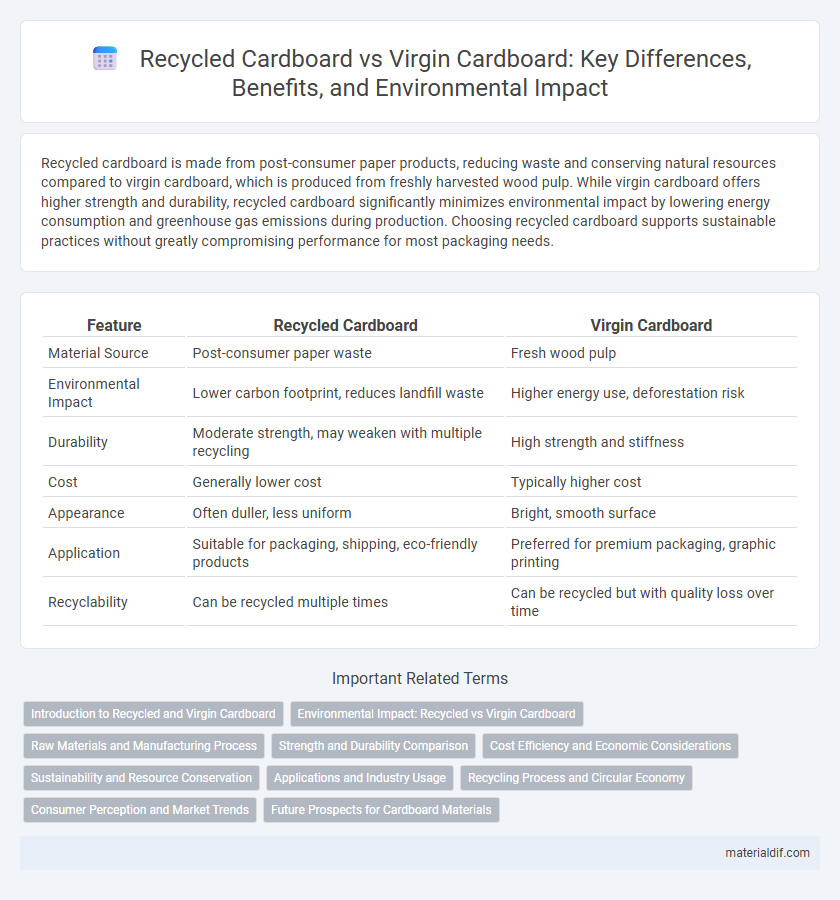Recycled cardboard is made from post-consumer paper products, reducing waste and conserving natural resources compared to virgin cardboard, which is produced from freshly harvested wood pulp. While virgin cardboard offers higher strength and durability, recycled cardboard significantly minimizes environmental impact by lowering energy consumption and greenhouse gas emissions during production. Choosing recycled cardboard supports sustainable practices without greatly compromising performance for most packaging needs.
Table of Comparison
| Feature | Recycled Cardboard | Virgin Cardboard |
|---|---|---|
| Material Source | Post-consumer paper waste | Fresh wood pulp |
| Environmental Impact | Lower carbon footprint, reduces landfill waste | Higher energy use, deforestation risk |
| Durability | Moderate strength, may weaken with multiple recycling | High strength and stiffness |
| Cost | Generally lower cost | Typically higher cost |
| Appearance | Often duller, less uniform | Bright, smooth surface |
| Application | Suitable for packaging, shipping, eco-friendly products | Preferred for premium packaging, graphic printing |
| Recyclability | Can be recycled multiple times | Can be recycled but with quality loss over time |
Introduction to Recycled and Virgin Cardboard
Recycled cardboard is made from post-consumer or post-industrial paper waste, reducing demand for raw materials and lowering environmental impact. Virgin cardboard is produced from fresh timber fibers, offering higher strength and purity but contributing to deforestation and higher carbon emissions. Sustainable packaging solutions increasingly favor recycled cardboard for its eco-friendly properties and resource efficiency.
Environmental Impact: Recycled vs Virgin Cardboard
Recycled cardboard significantly reduces environmental impact by lowering deforestation rates and conserving natural resources compared to virgin cardboard, which requires fresh wood pulp. The recycling process uses 40-50% less energy and produces fewer greenhouse gas emissions, contributing to a smaller carbon footprint. Waste diversion through recycling also decreases landfill usage, promoting sustainable material management in packaging industries.
Raw Materials and Manufacturing Process
Recycled cardboard is made from post-consumer and industrial paper waste, significantly reducing the demand for virgin wood fibers and lowering environmental impact. Virgin cardboard involves harvesting fresh timber, followed by pulping processes that consume more energy and water while generating higher emissions. The manufacturing process of recycled cardboard emphasizes de-inking and fiber recovery, which helps conserve natural resources compared to the more resource-intensive virgin pulp production.
Strength and Durability Comparison
Recycled cardboard typically exhibits reduced strength and durability compared to virgin cardboard due to fiber degradation during the recycling process. Virgin cardboard consists of fresh fibers, providing superior structural integrity and resistance to compression, making it ideal for heavy-duty packaging applications. While recycled cardboard is more environmentally friendly, its mechanical properties may limit its use in situations requiring high durability and load-bearing capacity.
Cost Efficiency and Economic Considerations
Recycled cardboard typically offers superior cost efficiency compared to virgin cardboard due to lower raw material expenses and reduced energy consumption in manufacturing processes. Economic considerations also favor recycled cardboard as its production supports waste reduction and circular economy initiatives, lowering overall environmental compliance costs. However, virgin cardboard may be preferred for applications requiring higher durability and strength, which can influence cost-benefit analyses depending on end-use requirements.
Sustainability and Resource Conservation
Recycled cardboard significantly reduces environmental impact by minimizing deforestation and lowering energy consumption compared to virgin cardboard, which requires fresh timber and more water resources. The recycling process conserves natural resources, reduces greenhouse gas emissions, and decreases landfill waste, enhancing overall sustainability. Choosing recycled cardboard supports circular economy principles, promoting resource efficiency and long-term ecological balance.
Applications and Industry Usage
Recycled cardboard is widely used in packaging, shipping, and storage industries due to its cost-effectiveness and environmental benefits, making it ideal for consumer goods and retail sectors. Virgin cardboard, characterized by its higher durability and strength, is preferred in food packaging, luxury product boxes, and applications demanding premium quality and structural integrity. Both materials serve crucial roles across industries, with recycled cardboard dominating eco-conscious markets and virgin cardboard favored where product protection and presentation are paramount.
Recycling Process and Circular Economy
Recycled cardboard involves repurposing post-consumer paper fibers through processes like deinking, pulping, and re-pressing, significantly reducing the need for virgin wood pulp and lowering environmental impact. Virgin cardboard production relies on fresh wood fiber, requiring intensive logging, energy, and water, contributing more to deforestation and carbon emissions. Incorporating recycled cardboard within the circular economy promotes resource efficiency, waste minimization, and the regeneration of materials, supporting sustainable manufacturing cycles.
Consumer Perception and Market Trends
Consumers increasingly prefer recycled cardboard for its environmental benefits, associating it with sustainability and eco-friendliness. Market trends reveal growing demand for recycled cardboard packaging, driven by brands seeking to reduce carbon footprints and appeal to green-conscious buyers. Despite some perceptions of virgin cardboard as stronger or higher quality, innovations in recycled cardboard manufacturing are narrowing the gap in performance and aesthetics.
Future Prospects for Cardboard Materials
Recycled cardboard offers significant environmental advantages by reducing waste and conserving natural resources, positioning it as a key material in sustainable packaging solutions. Virgin cardboard, derived directly from wood pulp, provides superior strength and durability, essential for heavy-duty applications but faces increasing pressure to improve eco-friendliness. Advances in recycling technology and the demand for eco-conscious products are driving innovation, suggesting a future where recycled cardboard may closely rival virgin cardboard's performance while minimizing ecological impact.
Recycled cardboard vs Virgin cardboard Infographic

 materialdif.com
materialdif.com